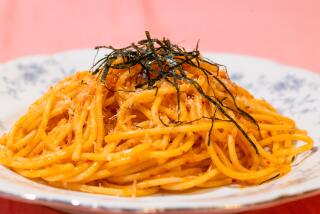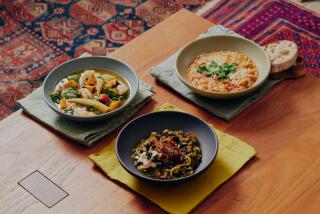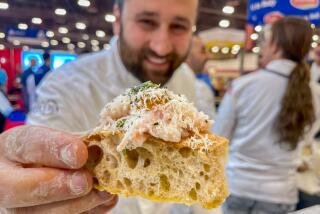Dinner in the real world
The idea of quick, flavorful weeknight cooking is nothing new. And neither is most of the advice. In 1930, when the great Edouard de Pomiane addressed the topic in his cookbook âFrench Cooking in Ten Minutes: or, Adapting to the Rhythm of Modern Life,â one of his first instructions was to start a pot of water boiling -- âWhatâs it for? I donât know, but itâs bound to be good for something.â
Well, I wouldnât presume to one-up Pomiane, but I can definitely tell you what that pot of boiling water is for in my kitchen: cooking dried pasta, the greatest friend a weeknight cook has ever had.
If you have some good dried pasta on hand, even just a chunk of dried-out cheese can be turned into a feast. (Youâll want to use spaghetti or another long, thin noodle; toss it with butter and then the grated cheese -- do it in this order to keep the cheese from clumping. A good grinding of black pepper is all you need to finish the dish.)
One of my favorite recipes is only a little more complicated than that. During the winter, it seems like I make pasta with broccoli almost once a week. Hereâs how it goes: Cook the broccoli and pasta in boiling water (they cook together at the same time); heat olive oil and garlic in a skillet; combine.
Really, thatâs all there is to it. But there can be more. A lot more. This dish is kind of a poster child for culinary flexibility. Iâve made it with broccoli, broccoli rabe and even Chinese broccoli. Itâs great with kale. You can add Italian sausage, salt pork, guanciale or prosciutto. You can go meatless with olives and capers (though this is even better with a few salted anchovies thrown in).
Last week, I made it with dandelion greens from my garden and a chunk of leftover Spanish chorizo cut in cubes; that might have been my favorite combination of all.
So you get what Iâm saying?
Letâs start by examining some of the fundamentals. In this case, the most important being the pasta itself.
You probably already know this, but dried pasta is not simply fresh pasta thatâs been left out too long. Rather, itâs a completely different animal. Fresh pasta is made with soft wheat and eggs and has a slinky, slippery texture. Dried pasta is made with hard wheat and water and is chewy and hearty. Itâs like the difference between silk and wool, and both have their uses.
Dried pastas come in a wide variety of shapes; some Italian purists will insist that each has only one ideal sauce that should accompany it. That may be true, but for most purposes, the choice is much simpler. Use long pastas (spaghetti, fettuccine, etc.) with sauces that have a creamy texture (the sauce will cling to the noodle). Use short pastas such as penne, farfalle and orecchiette with sauces that are chunky (the bits of sauce will cling to the nooks and crannies).
Though dried pasta seems as basic and reliable as an ingredient can get, there are differences in quality between brands, but perhaps in a surprising way. Tasted by itself, a really good dried pasta noodle may not seem all that much better than an ordinary brand; but what it does is make the sauce taste better. Itâs because of the ways the noodles are shaped (bronze dies make rougher surfaces) and dried (long, slow drying is better).
Thatâs Italian
As much as I would like to say that there are American brands that are as good as Italian, I have not found one yet. And that is also true of pasta from Italian brands that are made in this country. (To tell where a dried pasta was made, check the ingredient list. Italian noodles are made of only flour and water. If you see riboflavin or thiamine, no matter the brand name, the noodle was made in America.)
My favorite dried pastas are from such brands as Latini, Rustichella dâAbruzzo, Maestri and La Molisana. They are more expensive than average brands, but weâre still talking about dried pasta here: For me, an extra 50 cents a serving is a small enough luxury. If price is more important, both DeCecco and Barilla are fine. (Check the labels: Both are made in the U.S.)
Whichever pasta you use, the basics of cooking it are the same. The most important thing is that very big pot of very rapidly boiling water. Noodles throw off starch when theyâre cooking, and if there isnât enough water to dilute it, that starch turns into a gummy coating on the pasta. Also, make sure the water is heavily salted -- that will season the noodle and keep you from having to add so much salt afterward.
Recipes always tell you to cook pasta until it is al dente, but they never tell you exactly what that means. Thatâs because it varies from person to person. Fortunately, pasta is nothing if not adaptable. Some people like their noodles cooked to the point that you can gum them; pasta maker Carla Latini, who is so exigent that she and her husband Carlo make pasta from single varieties of wheat, likes her noodles cooked just long enough that they will bend into the pot (perhaps a slight exaggeration).
To my taste, pasta should be cooked just to the point that when you cut through a noodle, there is no hard white thread of uncooked flour remaining. At this point, the pasta is tender, but still chewy, which I suppose is about as good a definition of al dente as youâll find.
Over time, youâll learn to notice when the color changes from golden to pale straw, and youâll recognize that certain swelling and limpness that comes with a well-cooked noodle. But until then, thereâs only one surefire way to find when pasta is done, and thatâs to taste it. Pluck a single strand from the pot, using a long kitchen fork or a pair of tongs, let it cool slightly (careful, hot!), then pop it in your mouth.
As soon as itâs done, drain the pasta in a colander (having one of those colander inserts that fits inside your pot is a big help). Donât rinse it! Just shake off some of the excess water.
That was an awful lot of information for something as seemingly simple as dried pasta, but the noodles are the most important part of the dish. After that, everything else is pretty straightforward.
You can even cook the broccoli or whatever greens youâre using at the same time in the same pot in which youâre cooking the pasta. This is blanching -- cooking just long enough to make things tender. The trick is figuring the timing, and that is based on the density of the vegetable. Soft, leafy greens can be cooked in a minute or two; tough, woody stems can take as long as the noodles do.
In fact, with broccoli, add the diced stems at the same time you start the pasta and then add the florets when there is only a minute or two left.
The only thing left to make is the sauce, which for this particular pasta is essentially just olive oil and flavorings. This can be as simple as minced garlic by itself, or you can layer in other ingredients.
One obvious way to go is adding some kind of pork product, mainly because adding some kind of pork product will make almost anything taste better. Italian sausage is good -- either sweet or hot. Squeeze it out of its casing and break it into bite-sized chunks as you add it to the pan. Flatten it slightly with your fingers to increase the surface area so it will brown better (browned pork products are even better than plain pork products).
But remember that this sauce is really just seasoning. Anything besides raw sausage -- salted anchovies, olives, capers, whatever you like -- needs only to be heated through.
Watch the garlic
The one thing you want to be careful with is cooking the garlic. Donât let it scorch. If you see it beginning to go from golden to brown, immediately pull the pan from the heat and add a spoonful of the pasta water to stop the cooking.
The final fillip in the sauce-making part of the recipe is adding a ladleful of the pasta cooking water back into the saucepan. This accomplishes two things. Because there is so much starch in the water, it slightly thickens the sauce. More important, it marries the flavors of the sauce to the noodles.
To finish the dish, you just need a little cheese. Parmesan is a natural, of course, but I prefer pecorino Romano, which has a sharp, slightly funky sheepâs milk edge to it. Grate the cheese if you want, but I like it better sliced off in thin shards with a vegetable peeler. That way you get a nice, distinct bite, rather than little bits mixed in with everything else.
But you should try it both ways and make your own decision. Thatâs the beauty of learning to make a dish, rather than just following some recipe.
--
--
(BEGIN TEXT OF INFOBOX)
Pasta with broccoli and Italian sausage
Total time: 25 minutes
Servings: 6
1 head broccoli (about 3/4 pound)
2 links fresh Italian sausage ( 1/4 to 1/2 pound)
2 tablespoons olive oil
4 cloves garlic, minced
1/2 teaspoon red pepper flakes
1 pound dried short pasta, such as fusilli, penne, or ziti; or long dried pasta such as spaghetti
Salt, pepper
1 ounce pecorino Romano cheese
1. Bring a large pot of liberally salted water to a boil. While the water is heating, clean the broccoli: Separate the florets from the stems and set them aside. Remove the tough peel of the stems with a paring knife or vegetable peeler, then cut the stems into half-inch cubes. Remove the casings from the sausage.
2. Warm the olive oil in a large skillet over medium-low heat and crumble the sausage meat into the oil, flattening each piece slightly so it will brown better. Cook until the sausage browns and crisps. Add the garlic and red pepper flakes and cook until the garlic turns pale brown, about 5 minutes. Do not let the garlic scorch; if it begins to brown, remove the pan from the heat.
3. Add the pasta and the diced broccoli stems to the boiling water and cook 6 to 7 minutes. Add the broccoli florets and cook until the pasta is tender, about 10 minutes total. Scoop out the pasta and broccoli and drain; keep the water at a boil.
4. Place the skillet over high heat and add the drained broccoli and pasta to the sausage and garlic. Add one-half cup boiling water from the pasta pot. Cook, stirring frequently, until the water mostly boils away, about 1 1/2 to 2 minutes. Season to taste with salt and a good grinding of black pepper.
5. Divide the pasta evenly among 6 warmed pasta plates and shave pecorino Romano over the top with a vegetable peeler.
Each serving: 406 calories; 15 grams protein; 62 grams carbohydrates; 4 grams fiber; 11 grams fat; 3 grams saturated fat; 12 mg. cholesterol; 263 mg. sodium.
--
About this series
This year, youâre really going to learn to cook. How many New Yearâs have you promised yourself that? But this time, what with the state of the economy and all, that resolution seems an even better idea.
Weâre not talking about just memorizing a couple of recipes you can pull together for dinner parties. And weâre not talking about those meditative weekends spent constructing a fantasy out of some chefâs book.
Those things are fun, but they arenât much help when itâs 7 oâclock on a weeknight and you want dinner -- something tasty, something with style, something that doesnât come from the freezer or from a can.
At times like this, you really need to know how to cook, and that means looking at a dish not just as a set of ingredients and techniques, but as a structure that can be varied depending on what you have on hand and what you feel like eating.
And so, for the month of January, The Times Food section is offering an in-depth look at one main-course dish every week. Weâll take it apart and explain how it works. Then weâll walk you through some of the many ways it can be adapted.
If that sounds complicated, relax. These are all dishes that are intended to be put together quickly with ingredients that you either already have on hand or can stock up on from any neighborhood supermarket.
Even better, each recipe will be accompanied by a video at our food blog, latimes.com/dailydish. And if you have any questions -- or any go-to recipes of your own that youâd like to share -- let us know at the blog.
-- The Food staff
--
latimes.com
/DailyDish
Easy does dinner
Times Food Editor Russ Parsons shows you how to put this dish together in a video demonstration. Learn the basic technique -- then experiment.



